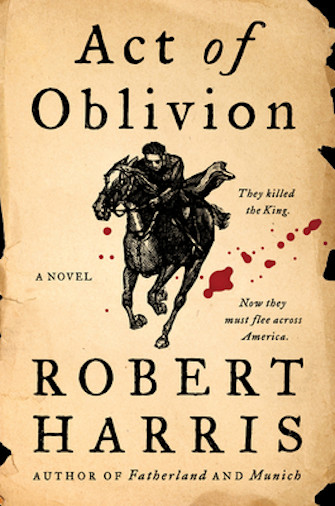Manhunt in the New World in Robert Harris’s ‘Act of Oblivion’

Act of Oblivion
By Robert Harris
Harper
480 pages
1661. Two English officers, Colonel William Goffe and his father-in-law Colonel Edward Whalley, flee England after King Charles II signs the Act of Oblivion—a call to execute 59 men who signed a death warrant for his father, King Charles I, 11 years earlier. Hot on the trail of these so-called “regicides” is Richard Nayler, Clerk of the Privy Council, charged with tracking them down, but most especially the signatories, Whalley and Goffe.
That’s a bare-bones summary of Act of Oblivion, Robert Harris’s new novel. But the story is about a lot more than that.
Some reviewers have described this novel—the latest in a long line of historical thrillers crafted by Harris—as proceeding at “breakneck speed.” That’s misleading. Act of Oblivion is more like a “slow build,” taking place over a span of 14 years, across oceans and continents. Many pages pass before Nayler, the Crown’s sworn manhunter, sails across the Atlantic to New England in search of the two colonels.
But because these characters—the fugitive officers and their relentless pursuer—are given time to grow, the relatively slow pace of the first hundred or so pages is hardly a barrier to enjoying the novel. The prose is admirably lucid throughout, as when Whalley and Goffe embark on a pre-dawn expedition to yet another hiding place on the North American frontier:

“It was difficult to see much in the darkness. The rutted mud had frozen into ridges overnight, hard as iron, that could break a man’s ankle if he wasn’t careful. They stumbled down the rough road, past the vague shapes of the houses on either side, setting off a barking dog. A light appeared in an upstairs window, and instinctively, despite the night, they pulled down the brims of their hats and bent their heads. Somewhere in the town, a cock was crowing.”
In Act of Oblivion, “real time” overtakes what could have been a more conventional (and time-limited) story of pursuit and capture. Years pass, people age, and some die in obscurity, rather than at the hands of the law. Harris makes readers complicit in this passage of time. We closely follow the desperate efforts by Whalley and Goffe (known more commonly as Ned and Will) to evade capture, while we’re also caught up in Nayler’s obsessive, years-long quest to apprehend them.
At the same time, Harris works hard to enlighten readers unfamiliar with religious conflicts in 17th century America. Readers who lack an in-depth knowledge of this era will nonetheless come away with a general grasp of the warring forces, and the novel’s focus never strays for long.
Within a more or less straightforward narrative, there are welcome flashes of wit, as when a minor character’s husband asks her opinion about something: “Mary’s opinion was that it was a little late in the day for him to start soliciting her views.” Late in the novel, Nayler’s philandering mistress returns home one night from a suspected tryst: “Her tone [upon entering] was unusually soft and affectionate, which generally meant she had just made love to someone else.”

Richard Nayler turns out to be very good at what he does, that is, locating and capturing the many signatories of King Charles I’s death warrant. The subsequent punishment of these men—including, but not limited to, hanging, castration, and dismemberment—is portrayed in just a few shocking pages. Only the fugitives in the New World elude his dragnet.
Ned and Will are sympathetic protagonists, even though most of the time their goal is simply locating a place of refuge in the wilderness. Nayler, who in addition to his official duties as a Clerk of the Privy Council has personal reasons for hunting them down, is more compellingly drawn.
Robert Harris is known for writing engaging, suspenseful novels based on historical events. Act of Oblivion is among his best so far.
Author Bio:
Lee Polevoi, Highbrow Magazine’s chief book critic, is the author of The Confessions of Gabriel Ash, a novel to be published in 2023.
For Highbrow Magazine
Image Sources:
--Ann Longmore-Etheridge (Flickr, Creative Commons)
--Harper
--Pxhere (Creative Commons)































































































































































































































































































































